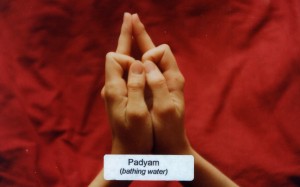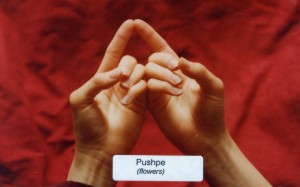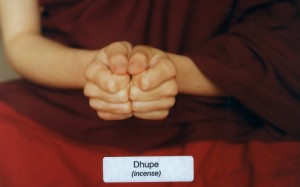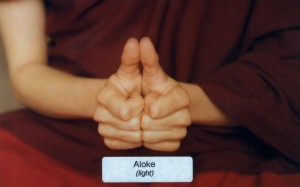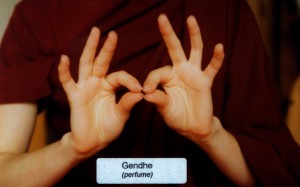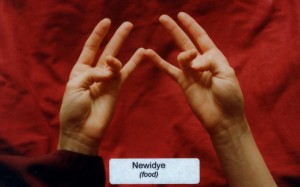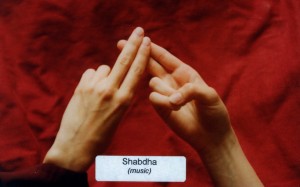The following was prepared by Ani Lucia Latimer:
At the time of the Buddha in ancient India, it was the custom of the day for devoted Buddhist households to make offerings to the Buddha and his monks and nuns as they traveled. Typically they would be offered clean water for drinking and bathing, flowers, incense, light or a lamp, perfume or fragrance and music. These offerings eventually became known as the 8 Auspicious Offerings and symbolize the coming forth of the Buddha’s precious teachings into the world. These same offerings are still used today on Tibetan Buddhist altars as a way to express gratitude and respect for the Buddha.
Typically on a Tibetan Buddhist Altar there are seven offering bowls and one light. They are arranged on the altar in a straight line close together. The distance between each bowl is about the width of a grain of rice. The water bowls are filled left to right and filled full but not overflowing. The water is poured evenly and steadily with smooth, regular movement. If the offering is poured in the correct way then it is said that beneficial outcome occurs and obscurations are dispelled. The closing of the altar is done in reverse, from right to left.
Deeper symbolic meaning and purpose has arisen for these offerings that correspond to a significant Buddhist prayer called the Seven Limb Puja or Prayer. Below is a list of the traditional offerings and what they represent.
First Offering Bowl: WATER for drinking “ARGHAM”
Pure, clean water offered to the Buddha for drinking and to cleanse the mouth or face. “The purity of the water has 8 qualities: crystal clarity, coolness, sweetness, lightness, softness, freedom from impurities. It is soothing to the stomach and makes the throat clear and free”. This offering symbolizes the auspicious results of all virtuous causes and conditions. In the Seven Limb Puja, it represents Homage & Prostration.
Second Offering Bowl: WATER for bathing “PADHYAM”
Pure, clean water offered for bathing our object of Refuge, the Buddha, and our precious Teacher. Typically the water was offered to bathe the feet and the water was scented with sandalwood or other sweet scent. This offering symbolizes purification of our negative karma and obscurations. In the Seven Limb Puja, it represents Offering.
Third Offering Bowl: FLOWERS “PUSHPE”
This offering represents all the various types of beautiful flowers in the entire universe that can be offered, as well as medicinal flowers, fruits and grains. It symbolizes the beauty and flowering of Enlightenment and signifies the opening of one’s heart. In the Seven Limb Puja, the flower represents Confession.
Fourth Offering Bowl: INCENSE “DHUPE”
Incense makes an offering of beautiful smell to the Buddha and symbolizes morality, ethics and discipline which are the basic causes and conditions from which pure enlightened qualities are cultivated. In the Seven Limb Puja, incense represents Rejoicing in all the virtue in the world both ordinary and extraordinary.
Fifth Offering Bowl: LIGHT “ALOKHE”
This offering comes in the form of light that includes all natural light such as the sun, moon and stars, as well as all types of man-made forms of light such as lamps and candles. The light symbolizes the dispelling of all darkness of the mind, all ignorance. Ignorance here means being ignorant or unaware of one’s true inherent Buddha Nature. Light is offered to the eyes of all the Enlightened ones who see with pristine clarity. In the Seven Limb Puja, light represents Requesting the Buddhas to always offer Dharma teaching.
Sixth Offering Bowl: PERFUME “GENDHE”
This offering represents all beautiful fragrance or perfume that one can smell or put on the body. Perfume is offered to the Buddha’s mind and symbolizes the perseverance and joyful effort that is the heart of Enlightenment. Without perseverance all the other enlightened qualities could not arise in the mind. In the Seven Limb Puja, perfume represents Beseeching the Buddhas to remain in the world.
Seventh Offering Bowl: CELESTIAL FOOD “NEVIDHYA”
Excellent, delicious food of all kinds and various tastes is offered to the Three Jewels. This offering symbolizes the clear and stable mind of Samadhi, or meditative absorption. In the Seven Limb Puja, food represents Dedication of all merit for the benefit of all sentient beings.
Eighth Offering Bowl: MUSIC “SHABTA”
Musical instruments such as cymbals, bells, lutes, and string instruments that create beautiful sound is offered to the ears of the Buddha. Sound symbolizes the Buddha’s Wisdom nature and the extraordinary Compassion that arises naturally from the Wisdom mind.
References:
The Stanzas of Offering Water from the Pure Vision, An Ocean of Blessings by Dudjom Rinpoche
The Significance of the Eight Offerings from a talk given by Khenpo Karthar in May, 1993 at Kunzang Palyul Choling


